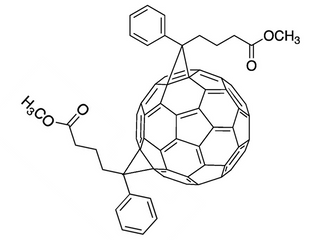bis-PCBM (PC60BM Bisadduct)
CAS Number 1048679-01-1
Fullerenes for Photovoltaics and Biotechnology, MaterialsImprove Open Circuit Voltage of Solar Cells
For OPV applications and crystallization studies
Product Information | MSDS | Literature and Reviews | Resources and Support
Bis(1-[3-(methoxycarbonyl)propyl]-1-phenyl)-[6,6]C62 or bis[C60]PCBM, also known as a PCBM bisadduct, is used to increase the open circuit voltage of solar cells by approximately 0.1 V due to the higher lying LUMO level [1]. This material is also used in crystallization studies, especially when comparing polymer-fullerene packing [2,3].
High Purity
>99.5% material purity
Soluble Fullerene Acceptor
For high efficiency OPVs
Higher Lying LUMO Energy Level
Improve open circuit voltage
Worldwide Shipping
Quick and reliable shipping
Product Information
| CAS number | 1048679-01-1 |
|---|---|
| Purity | >99.5% |
| Molecular Weight | 1101.1 g/mol |
Chemical Structure

Pricing
| Product Code | Purity | Quantity | Price |
|---|---|---|---|
| M191 | >99.5% | 200 mg | £380 |
| M191 | >99.5% | 500 mg | £760 |
MSDS Documentation
Literature and Reviews
- Fullerene Bisadducts for Enhanced Open-Circuit Voltages and Efficiencies in Polymer Solar Cells, M. Lenes et al., Advanced Materials, 20, 2116 (2008)
- Tuning the Properties of Polymer Bulk Heterojunction Solar Cells by Adjusting Fullerene Size to Control Intercalation, N. Cates et al., Nano Letters, 9, 4153 (2009)
- Effects of Intercalation on the Hole Mobility of Amorphous Semiconducting Polymer Blends, N. Cates et al., Chemistry of Materials, 22, 3543 (2010)
Resources and Support
 Polymer-Fullerene Bulk Heterojunction Solar Cells
Polymer-Fullerene Bulk Heterojunction Solar Cells
Polymer-fullerene bulk heterojunction (BHJ) solar cells are based on blends of semiconducting polymers and fullerene derivatives, such as PCBM. It is described as a bulk heterojunction as it involves a blend of two materials with differing energy band gaps, forming a dispersed, interpenetrating network.
Read more...